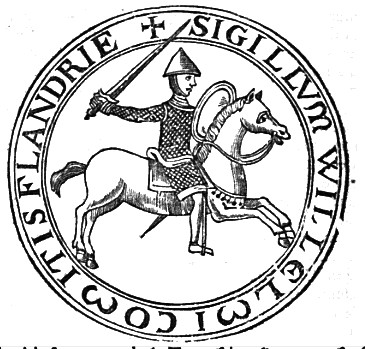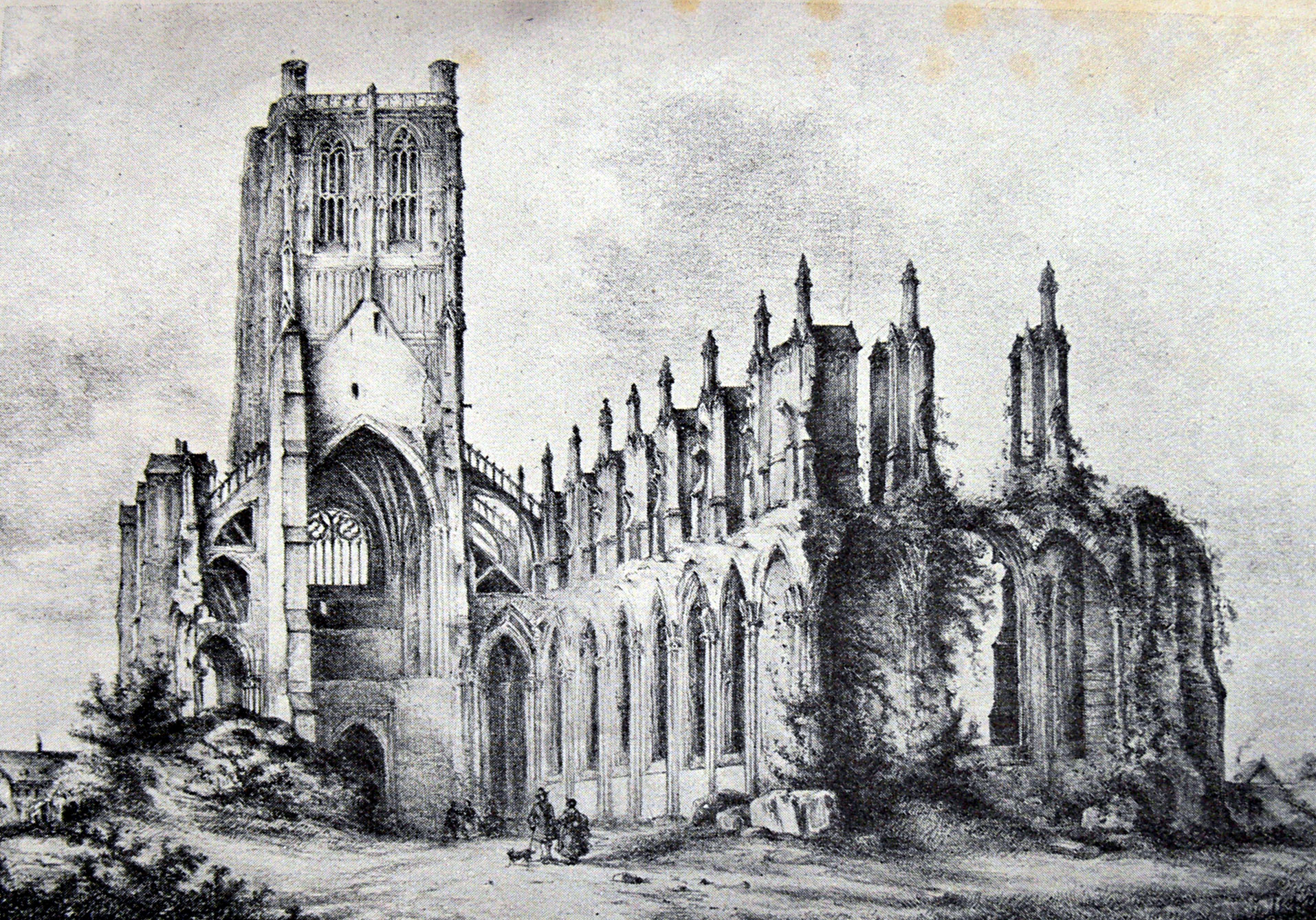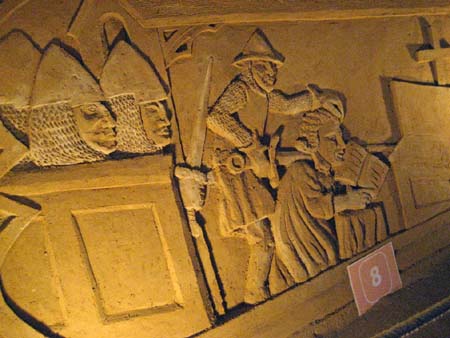|
Battle Of Axspoele
The Battle of Axspoele (sometimes Axpoele or Thielt) took place on 21 June 1128 on the Heerlijkheid, landed estate of the lords of Axpoele in the County of Flanders between William Clito and Thierry, Count of Flanders, Thierry of Alsace. The two men were rivals for the title of Count of Flanders. William had been appointed to the title by Louis VI of France following the 1127 murder of Charles the Good but Thierry, cousin of Charles, had the support of Henry I of England. In 1128, Thierry secured the support of a number of Flemish cities, although most of the nobility supported William. Thierry led a force of 300 mounted Man-at-arms, men-at-arms and 1,500 Infantry in the Middle Ages, infantrymen to Axspoele on 19 June to lay siege to a castle held by one of William's supporters. William was aware of Thierry's movements and moved with a force of 450 men-at-arms to raise the siege. On arrival he recognized that most of Thierry's army was infantry and decided to give battle. He positi ... [...More Info...] [...Related Items...] OR: [Wikipedia] [Google] [Baidu] |
Ruiselede
Ruiselede (; ; historically Ruysselede) is a former municipality located in the Belgian province of West Flanders. This town only comprises the town of Ruiselede proper. On January 1, 2006, Ruiselede had a total population of 5,113. The total area is 30.20 km2 which gives a population density Population density (in agriculture: Standing stock (other), standing stock or plant density) is a measurement of population per unit land area. It is mostly applied to humans, but sometimes to other living organisms too. It is a key geog ... of 169 inhabitants per km2. Ruiselede was the location of a coastal radio site. From 1923 to 1940 it had a VLF aerial. On 30 December 1933, the mast was demolished when an aircraft collided with it. Gallery File:Onze-Lieve-Vlouv-ten-Hemelopnemingskerk, Ruiselede (DSCF0084).jpg, References External links * Wingene Former municipalities of West Flanders {{WestFlanders-geo-stub ... [...More Info...] [...Related Items...] OR: [Wikipedia] [Google] [Baidu] |
Thierry Of Flanders
Theoderic (, , ; – 17 January 1168), commonly known as Thierry of Alsace, was the fifteenth count of Flanders from 1128 to 1168. With a record of four campaigns in the Levant and Africa (including participation in the Second Crusade, the failed 1157–1158 siege of the Syrian city Shaizar, and the 1164 invasion of Egypt), he had a rare and distinguished record of commitment to crusading. Countship Theoderic was the youngest son of Duke Theoderic II of Lorraine and Gertrude, daughter of Count Robert I of Flanders. After the murder of his cousin, Charles the Good, in 1127, Theoderic claimed the County of Flanders, but another cousin, William Clito, became count instead with the support of King Louis VI of France. William's politics and attitude towards the autonomy of Flanders made him unpopular, and by the end of the year Bruges, Ghent, Lille, and Saint-Omer recognized Theoderic as a rival count. Theoderic's supporters came from the Imperial faction of Flanders. Louis VI o ... [...More Info...] [...Related Items...] OR: [Wikipedia] [Google] [Baidu] |
Conflicts In 1128
Conflict may refer to: Social sciences * Conflict (process), the general pattern of groups dealing with disparate ideas * Conflict continuum from cooperation (low intensity), to contest, to higher intensity (violence and war) * Conflict of interest, involvement in multiple interests which could possibly corrupt the motivation or decision-making * Cultural conflict, a type of conflict that occurs when different cultural values and beliefs clash * Ethnic conflict, a conflict between two or more contending ethnic groups * Group conflict, conflict between groups * Intragroup conflict, conflict within groups * Organizational conflict, discord caused by opposition of needs, values, and interests between people working together * Role conflict, incompatible demands placed upon a person such that compliance with both would be difficult * Social conflict, the struggle for agency or power in something * Work–family conflict, incompatible demands between the work and family roles of a ... [...More Info...] [...Related Items...] OR: [Wikipedia] [Google] [Baidu] |
Aalst, Belgium
Aalst (; , ; Brabantian dialect, Brabantian: ''Oilsjt'') is a City status in Belgium, city and Municipalities in Belgium, municipality in the province of East Flanders in the Flemish Region of Belgium. It is located on the Dender River, about northwest of Brussels. The municipality comprises the city of Aalst itself and the villages of Baardegem, Erembodegem, Gijzegem, Herdersem, Hofstade, Meldert, Moorsel and Nieuwerkerken; it is the tenth largest city by population with 90.068 inhabitants. Aalst is crossed by the Molenbeek-Ter Erpenbeek in Aalst and Hofstade. The current mayor of Aalst is Christoph D'Haese, from the Nieuw-Vlaamse Alliantie, New-Flemish Alliance party. The town has a long-standing folkloric feud with Dendermonde, north along the same river, which dates from the Middle Ages. History The first historical records on Aalst date from the 9th century, when it was described as the ''villa Alost'', a dependency of the Abbey of Lobbes. During the Middle Ages, a town ... [...More Info...] [...Related Items...] OR: [Wikipedia] [Google] [Baidu] |
Heilig Kruisbeeld In Ruiselede In 2018
Heilig may refer to: *Heilig-Geist-Gymnasium, several schools *Heilig (surname) *Morton Heilig Morton Leonard Heilig (December 22, 1926 – May 14, 1997) was an American pioneer in virtual reality (VR) technology and a filmmaker. He applied his cinematographer experience and with the help of his partner developed the Sensorama over several ... (1926–1997), American cinematographer and innovator of Virtual Reality (VR) cinematography * "Heilig" (E Nomine song), 2007 * "Heilig" (Tokio Hotel song), 2008 {{dab ... [...More Info...] [...Related Items...] OR: [Wikipedia] [Google] [Baidu] |
High Middle Ages
The High Middle Ages, or High Medieval Period, was the periodization, period of European history between and ; it was preceded by the Early Middle Ages and followed by the Late Middle Ages, which ended according to historiographical convention. Key historical trends of the High Middle Ages include the medieval demography, rapidly increasing population of Europe, which brought about great social and political change from the preceding era, and the Renaissance of the 12th century, including the first developments of rural exodus and urbanization. By 1350, the robust population increase had greatly benefited the European economy, which had reached levels that would not be seen again in some areas until the 19th century. That trend faltered in the early 14th century, as the result of numerous events which together comprised the crisis of the late Middle Ages—most notable among them being the Black Death, in addition to various regional wars and economic stagnation. From , Europ ... [...More Info...] [...Related Items...] OR: [Wikipedia] [Google] [Baidu] |
Sacrament Of Penance
The Sacrament of Penance (also commonly called the Sacrament of Reconciliation or Confession) is one of the seven sacraments of the Catholic Church (known in Eastern Christianity as sacred mysteries), in which the faithful are absolved from sins committed after baptism and reconciled with the Christian community. During reconciliation, mortal sins must be confessed and venial sins may be confessed for devotional reasons. According to the dogma and unchanging practice of the church, only those ordained as priests may grant absolution. Nature The church teaches, based on the Parable of the Prodigal Son, that confession is not a tribunal or criminal court, where one is condemned by God like a criminal, but a "wedding banquet hall, where the community celebrates Easter, Christ's victory over sin and death, in the joyful experience of his forgiving mercy." In confession, the church believes, God judges a person in the sense of bringing to light his or her sins, by granting the pe ... [...More Info...] [...Related Items...] OR: [Wikipedia] [Google] [Baidu] |
Abbey Of St
An abbey is a type of monastery used by members of a religious order under the governance of an abbot or abbess. Abbeys provide a complex of buildings and land for religious activities, work, and housing of Christian monks and nuns. The concept of the abbey has developed over many centuries from the early monastic ways of religious men and women where they would live isolated from the lay community about them. Religious life in an abbey may be monastic. An abbey may be the home of an enclosed religious order or may be open to visitors. The layout of the church and associated buildings of an abbey often follows a set plan determined by the founding religious order. Abbeys are often self-sufficient while using any abundance of produce or skill to provide care to the poor and needy, refuge to the persecuted, or education to the young. Some abbeys offer accommodation to people who are seeking spiritual retreat. There are many famous abbeys across the Mediterranean Basin and ... [...More Info...] [...Related Items...] OR: [Wikipedia] [Google] [Baidu] |
Abbey Of Saint Bertin
The Abbey of Saint Bertin was a Benedictine monastic abbey in Saint-Omer, France. The buildings are now in ruins, which are open to the public. It was initially dedicated to but was rededicated to its second abbot, . The abbey is known for its Latin cartulary (') whose first part is attributed to Folcwin. The abbey was founded on the banks of the Aa in the 7th century by Bishop Audomar of Thérouanne, who is now better known as . He sent the monks Bertin, Momelin, and Ebertram from Sithiu (now St-Omer) to proselytize among the pagans in the region. The abbey soon became one of the most influential monasteries in northern Europe and ranked in importance with Elnon (now St-Amand Abbey) and . Its library included the codex of the Leiden Aratea, from which two copies were made. The Annals of St Bertin are an important source of the history of 9th-century France. Already in the 9th century, the abbey had a priory in Poperinge. A Romanesque church was constructed in the ... [...More Info...] [...Related Items...] OR: [Wikipedia] [Google] [Baidu] |
Latin (language)
Latin ( or ) is a classical language belonging to the Italic branch of the Indo-European languages. Latin was originally spoken by the Latins in Latium (now known as Lazio), the lower Tiber area around Rome, Italy. Through the expansion of the Roman Republic, it became the dominant language in the Italian Peninsula and subsequently throughout the Roman Empire. It has greatly influenced many languages, including English, having contributed many words to the English lexicon, particularly after the Christianization of the Anglo-Saxons and the Norman Conquest. Latin roots appear frequently in the technical vocabulary used by fields such as theology, the sciences, medicine, and law. By the late Roman Republic, Old Latin had evolved into standardized Classical Latin. Vulgar Latin refers to the less prestigious colloquial registers, attested in inscriptions and some literary works such as those of the comic playwrights Plautus and Terence and the author Petronius. While ... [...More Info...] [...Related Items...] OR: [Wikipedia] [Google] [Baidu] |
Galbert Of Bruges
Galbert of Bruges (Galbertus notarius Brugensis in Latin) was a Flemish cleric and chronicler. A resident of Bruges and a functionary in the administration of the count of Flanders, he is known for his day-by-day Latin account ''De multro, traditione et occisione gloriosi Karoli comitis Flandriarum'' of the events surrounding the murder of Count Charles the Good in 1127 and the ensuing civil war in Flanders up to the accession of Thierry of Alsace as count in the summer of 1128. References *Alan V. Murray. 1994. ‘Voices of Flanders: Orality and Constructed Orality in the Chronicle of Galbert of Bruges’, ''Handelingen der Maatschappij voor Geschiedenis en Oudheidkunde te Gent'' n.s. 48, pp. 103–119 *Jeff Rider (translator). 2013. ''The Murder, Betrayal, and Slaughter of the Glorious Charles, Count of Flanders'' by Galbert of Bruges. New Haven and London: Yale University Press. . *Jeff Rider (editor). 1994. ''De multro, traditione, et occisione gloriosi Karoli comitis Fland ... [...More Info...] [...Related Items...] OR: [Wikipedia] [Google] [Baidu] |
Robert I, Count Of Flanders
Robert I ( – 13 October 1093), known as Robert the Frisian, was count of Flanders from 1071 until his death in 1093. He was a son of Baldwin V, Count of Flanders, and the younger brother of Baldwin VI, Count of Flanders. He usurped the countship after defeating his nephew Arnulf III and his allies, which included King Philip I of France, Count Eustace of Boulogne and the counts of Saint-Pol and Ardres at the Battle of Cassel. Charles Verlinden, ''Robert Ier le Frisson'', Ghent, 1935. He subsequently made peace with Philip, who became his stepson-in-law, but remained hostile to his sister Matilda and her husband William the Conqueror, who was king of England and duke of Normandy. Early life Robert was the younger son of Baldwin V of Flanders and Adela, a daughter of King Robert II of France.Detlev Schwennicke, '' Europäische Stammtafeln: Stammtafeln zur Geschichte der Europäischen Staaten'', Neue folge, Band II (Marburg, Germany: Verlag von J. A. Stargardt, 1984), Tafel ... [...More Info...] [...Related Items...] OR: [Wikipedia] [Google] [Baidu] |






